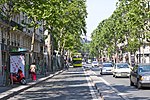Hotel La Louisiane
Hotel La Lousiane is a Parisian hotel located at the heart of Saint-Germain-des-Prés at the intersection of rue de Buci and rue de Seine in the sixth arrondissement. It has a main entrance on 60, rue de Seine and a side entrance on 27 rue de Buci. It sits at the crossroad between four central lines: the Passarella des Arts (N), the Luxembourg Garden, (S), rue St Guillaume, (W) and place St Michel, (S). It is most associated with jazz musicians of the 1950s and 1960s. Oscar Peterson, Miles Davis, Bud Powell, Max Roach, Dizzy Gillespie, Art Blakey, Billie Holiday, Lester Young and Charlie Parker all stayed at the hotel. In the early 1960s, Powell and his wife Buttercup resided at the hotel for a long period.In 1954, a double portrait of Lucian Freud, In Shadow Against the Light from the Window, With His Second Wife, Caroline Blackwood was painted in the hotel. It is on display at the Beaverbrook Art Gallery in Fredericton, Canada.
Excerpt from the Wikipedia article Hotel La Louisiane (License: CC BY-SA 3.0, Authors).Hotel La Louisiane
Rue de Seine, Paris Quartier de Saint-Germain-des-Prés (Paris)
Geographical coordinates (GPS) Address Nearby Places Show on map
Geographical coordinates (GPS)
| Latitude | Longitude |
|---|---|
| N 48.8536 ° | E 2.3369 ° |
Address
Rue de Seine 60
75006 Paris, Quartier de Saint-Germain-des-Prés (Paris)
Ile-de-France, France
Open on Google Maps










